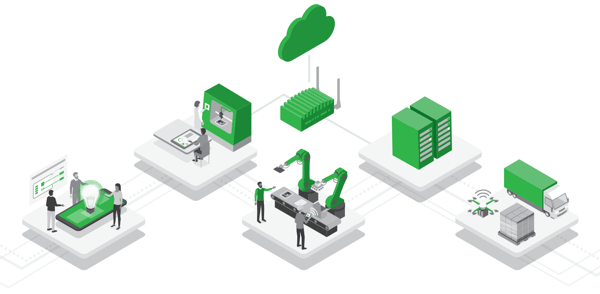Key Takeaways:
- Several misconceptions about industrial automation hinder adoption in manufacturing.
- Automation improves efficiency and doesn't always replace human workers.
- Embracing automation helps manufacturers remain competitive and adaptive.
As with any new technology, there has been both a lot of hype and a lot of fear surrounding industrial automation. It can be difficult to separate fact from fiction with so many myths proliferating across the internet. These fluctuations in perception are to be expected, though. They are primary aspects of the hype cycle, a progression of events that impacts nearly all truly disruptive technologies from discovery, through early adoption, and into mass adoption. Industrial automation follows the same curve as its technological predecessors, a fact that offers solidity to its benefits and staying power.
We’re here to debunk some of the myths that have been floating around about industrial automation in an attempt to better align expectations and reality about the capacity of this technology.
Here are the four common lies about industrial automation that we will be discussing:
Robots Do Everything Better Than Humans
“Anything you can do, I can do better…” 🎵 In this case, “No you can’t,” is the right answer (for now) when it comes to robot vs. human skill sets. In an ideal automated manufacturing facility, humans and robots work alongside one another, each bringing a unique set of strengths and proficiencies to the table.
Tasks robots do better include:
- Performing repetitive tasks, even if they are complex
- Learning how to do new tasks. While humans require a whole matter of onboarding and training, a new robot can simply be equipped with the already tried-and-true software.
- Performing high-speed mechanical tasks
- Maintaining precision, accuracy, consistency, and reliability. After all, robots are not prone to the flu and don’t get lost in thought about what they’re having for lunch. “To err is human” is apt.
- Robots do not require a clean, oxygen-rich, temperate, dry environment to function. They can work underwater, in extreme heat, and a variety of other hostile conditions that can arise in a manufacturing facility.
 In building a factory of the future, humans need machines as much as machines need humans.
In building a factory of the future, humans need machines as much as machines need humans.
Automation Is Expensive And Time-Consuming To Implement
When technologies first hit the market, people pay a premium. Think of the personal computer. The first small(ish) business PC from Hewlett-Packard, the HP 3000, cost an inflation-adjusted price of $571,791 in 1972.
Luckily, automation has moved on from the super-new, ultra-expensive technology bracket and into the mainstream. It’s much more affordable to install automation equipment in a factory today, and companies will see ROI much faster than in years past through a combination of better, more refined technology and very reasonable price tags. The benefits are cyclical—automation lowers the price of goods while it increases labor productivity.
In terms of time commitment, the duration of initial implementation has shrunk as well. Some forms of industrial automation can be deployed literally in a matter of minutes, often even in a DIY capacity such as with the MachineMetrics plug-and-play adaptors.
All The Manufacturing Jobs Are Being Replaced With Automation
This is definitely one of those myths that’s rooted in fear. People envision a dystopian future where robots do everything and all humans not in the upper echelons of wealth are starving in the streets with no job in sight. In reality, however, automation—including robotics and artificial intelligence—make human labor more valuable, some say to the extent of being a luxury.
The reality is that automation brings a host of new jobs while taking over the most boring, redundant, and dangerous activities for human workers. More workers with technical expertise and technological fluency will be employed for a wide range of tasks in support of the machines. Human skills such as emotional intelligence, communication, creativity, and intuition are also still welcome in the workforce, especially in leadership positions. The more likely scenario is that we will work more closely alongside our automated counterparts as long as we’re willing to grow and learn rather than be kicked to the curb.
Even in the advanced automated lights out operations, humans play an incredibly important role in supervising and enabling automation, maintaining production, and looking for opportunities to optimize production.
It’s A Coin Toss Whether Or Not Automation Will Work For A Manufacturer
This goes back to that same old view of manufacturing mentioned in the PC analogy above. Once upon a time, implementing (very expensive) automation was a crapshoot for manufacturers—it might work, it might not. There was a lot more testing and refinement at a much slower pace, and these investments sometimes never paid off.
Fast forward to the ‘20s, and this concept is far less prevalent. Barring super experimental automation technologies, most of the stuff on the market is pretty reliable, far less expensive, and improving rapidly. With many solution providers to choose from and an unprecedented level of tailoring, automation programs are far likelier to be successful.
MachineMetrics offers the tools and expertise for production monitoring, condition monitoring, predictive maintenance, and process optimization for manufacturers using unique plug-and-play devices with out-of-the-box usability and ROI in as short as five days.



.png?width=1960&height=1300&name=01_comp_Downtime-%26-Quality_laptop%20(1).png)


.gif)









Comments